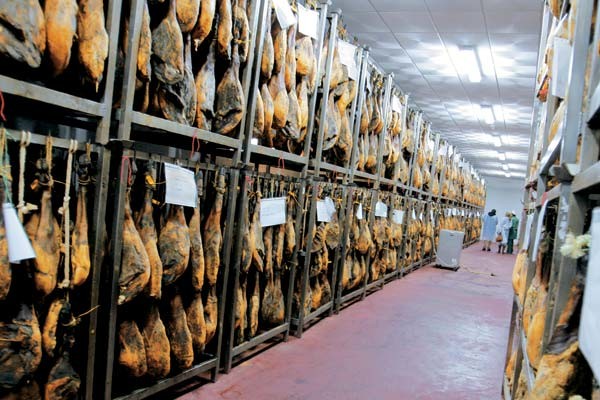 Hamon Spanish On the Iberian Peninsula, anyham, even boiled and in a plastic shell, it is customary to call a hamon. Perhaps that's why the Spaniards do not feel any special respect for this word. After all, it's true, it's hard to treat with the pathos to eating every day for breakfast, lunch or dinner. But among a variety of ham assortment there are real masterpieces that are "equated" with national treasures. And above all it's Pata negra, which translates as "black leg". Hamon with such a prosaic name is made from pig meat of a unique Iberian breed. These animals are not only externally different from their fellow humans, but also live in special "royal" conditions. Everyone who has been to Spain knows that in almost every city there is a restaurant or bar called Museo del Jamon, or, in Russian, The Museum of Ham. Hanging down from the ceiling and exuding an appetizingly callous smell of dried pork ham - not only the main decoration of institutions, but also the main "heroes" of the menu. Here you can try a variety of specialties, prepared from a jamon. And if in this list of dishes an inexperienced visitor can easily get lost, then with the choice of the ham it's very simple: there are only two kinds of it - "Iberico" or "Serrano".
Hamon Spanish On the Iberian Peninsula, anyham, even boiled and in a plastic shell, it is customary to call a hamon. Perhaps that's why the Spaniards do not feel any special respect for this word. After all, it's true, it's hard to treat with the pathos to eating every day for breakfast, lunch or dinner. But among a variety of ham assortment there are real masterpieces that are "equated" with national treasures. And above all it's Pata negra, which translates as "black leg". Hamon with such a prosaic name is made from pig meat of a unique Iberian breed. These animals are not only externally different from their fellow humans, but also live in special "royal" conditions. Everyone who has been to Spain knows that in almost every city there is a restaurant or bar called Museo del Jamon, or, in Russian, The Museum of Ham. Hanging down from the ceiling and exuding an appetizingly callous smell of dried pork ham - not only the main decoration of institutions, but also the main "heroes" of the menu. Here you can try a variety of specialties, prepared from a jamon. And if in this list of dishes an inexperienced visitor can easily get lost, then with the choice of the ham it's very simple: there are only two kinds of it - "Iberico" or "Serrano". 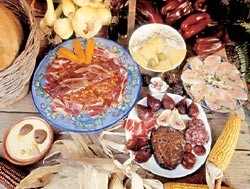 Their volume of production can be delineated into twostrongly unequal parts. One, much more - about 90%, is "hamon serrano". Without a doubt, this product is worthy of the highest praise. Its quality is monitored by the certification authority Consorcio del Jamon Serrano Espanol. And the Spanish consortiums, designed to control the technology of production, even a mouse without a check will not slip through - still, on this depends the prestige of national products and, ultimately, the contribution to the economy of the country. But still, despite the excellent taste of "Serrano", it is a product for daily use. His Spaniards prefer to send for export, not without reason believing that foreigners spoiling themselves with a hamon only from time to time are not given the opportunity to understand such subtleties. For themselves, they save much more expensive "jamon Iberico", which they themselves buy to decorate the festive table during secular and religious holidays. It is said that the day of King Juan Carlos starts from the plate of this jamon. True, with the light hand of the crown prince of the throne of the Asturian Felipe, it is possible that not only the Spaniards will be able to learn the taste advantages of the "Iberico jamon": at the International Congress on the Iberian ham, held in the city of Teruel, the prince solemnly promised delegates that he would advertise this ham during his trips around the world.
Their volume of production can be delineated into twostrongly unequal parts. One, much more - about 90%, is "hamon serrano". Without a doubt, this product is worthy of the highest praise. Its quality is monitored by the certification authority Consorcio del Jamon Serrano Espanol. And the Spanish consortiums, designed to control the technology of production, even a mouse without a check will not slip through - still, on this depends the prestige of national products and, ultimately, the contribution to the economy of the country. But still, despite the excellent taste of "Serrano", it is a product for daily use. His Spaniards prefer to send for export, not without reason believing that foreigners spoiling themselves with a hamon only from time to time are not given the opportunity to understand such subtleties. For themselves, they save much more expensive "jamon Iberico", which they themselves buy to decorate the festive table during secular and religious holidays. It is said that the day of King Juan Carlos starts from the plate of this jamon. True, with the light hand of the crown prince of the throne of the Asturian Felipe, it is possible that not only the Spaniards will be able to learn the taste advantages of the "Iberico jamon": at the International Congress on the Iberian ham, held in the city of Teruel, the prince solemnly promised delegates that he would advertise this ham during his trips around the world. 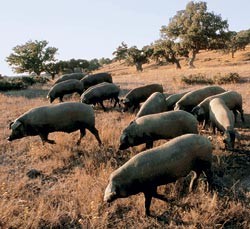 Swin Life Why Iberich was awarded the titlegrandpa, and only Hidalgo is serrano? After all, one and the second, in fact, nothing more than raw hams made using similar technology. There are only two differences between them. The first is in the breed of grunting raw materials. And the second - in the composition of feed. For the production of the "Iberico jamon", exclusively pigs of the black Iberian breed are used, which are descendants of wild pigs, which in ancient times dwelt on the shores of the Mediterranean Sea, in the forests of the Sierra Morena. This is the only freely grazing domesticated breed in Europe, part of an old ecosystem that has been preserved exclusively in the south-western regions of the Iberian Peninsula. True, freedom of these animals is very relative. According to the law, pigs raised for the production of "Iberico jam" should have at least 75% of noble "Iberian" blood. Therefore, their behavior and private life are monitored very seriously. In their ears - a kind of piercing. On one earring you can read information about the mother, on the second - about the father. Another ring is inserted into the patch. Because if you do not, the wonderful Spanish oaks, under which the elite of the pork kingdom graze, will perish by a quick and terrible death, described in Krylov's famous fable. Pig - she is a pig, though noble blood, though not.
Swin Life Why Iberich was awarded the titlegrandpa, and only Hidalgo is serrano? After all, one and the second, in fact, nothing more than raw hams made using similar technology. There are only two differences between them. The first is in the breed of grunting raw materials. And the second - in the composition of feed. For the production of the "Iberico jamon", exclusively pigs of the black Iberian breed are used, which are descendants of wild pigs, which in ancient times dwelt on the shores of the Mediterranean Sea, in the forests of the Sierra Morena. This is the only freely grazing domesticated breed in Europe, part of an old ecosystem that has been preserved exclusively in the south-western regions of the Iberian Peninsula. True, freedom of these animals is very relative. According to the law, pigs raised for the production of "Iberico jam" should have at least 75% of noble "Iberian" blood. Therefore, their behavior and private life are monitored very seriously. In their ears - a kind of piercing. On one earring you can read information about the mother, on the second - about the father. Another ring is inserted into the patch. Because if you do not, the wonderful Spanish oaks, under which the elite of the pork kingdom graze, will perish by a quick and terrible death, described in Krylov's famous fable. Pig - she is a pig, though noble blood, though not. 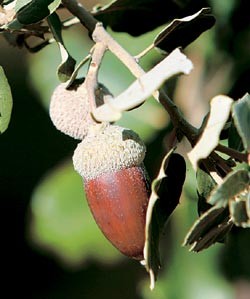 The acorns of Spanish oaks are special. They contain a large amount of carbohydrates and vegetable oils, which penetrate into the meat of animals. Without such food, it is impossible to grow up true Ibericos. The government of Extremadura, which manages this cattle-breeding region, even published a law on pastures in which it indicated that the owners of land are not owners of oaks growing in their territory: they are not allowed to cut dried branches without special permission from the special commission. The number of animals in pastures should not exceed 15 pigs per hectare. On free grazing, already transferred podschennyh one-year-old pigs weighing from 80 to 105 kg. Here they must get at least 60% of their pre-grazing weight. If the pig is absolutely clean blood, then the volume of its growth should be at least 75%. The period, called the "acorn season", lasts from October 15 to February 15. By its end, pigs gain from 150 to 180 kg. After that they are sent to the face. The only thing that can prolong their short, but privileged life, however, not more than a month, is an insufficient gain in weight. It should be noted that this breed is the most important in the world's genetic heritage. Its unique feature is in the taste and delicate texture of the meat. No less interesting is the fact that jamon, as doctors have established, is able to lower the level of cholesterol in the blood. This curious fact was confirmed by studies of the state of health of nuns from Extremadura (region of Spain). They for a few years, exclusively for scientific purposes, ate a jamon. At first, for some of them, especially for those who came from Latin America and India, the unusual food was a real torture: they even tried to spread it with jam, but then gradually got used to it and even fell in love. The dynamics of positive changes allowed scientists to state that jamon is not only a tasty, but also a useful product. For "hamon serrano" pigs are grown simpler, mostly white "Durokidsi" breed. They often do not see acorns, not even oaks. Table of ranks The most expensive is "hamon iberiko bayot". This is the back leg of a black Iberian pig, the fattening of which occurred according to the most expensive diet, acorn. Be prepared for the fact that the price of this ham will surprise you unpleasantly. More expensive, most likely, in the store there is nothing at all. If the pig was fattened on a diet "ressevo", that is, on a mixture of acorns with a specially selected forage, which includes aromatic herbs, which is also very expensive, it will certainly be reflected in the name of the ham - "hamon iberiko ressevo." "Hamon Serrano "Are made from the hams of a white-breed pig, regardless of whether or not it will be grazed under oaks. Only for the hamons of the white pig at the end of the name can be added an indication of the time of aging in the cellars. Bodega - no less than 12 months, Reserva - at least 9 months, Curado - up to 7 months. All the same applies to the forelimbs of pigs, but only instead of the word "hamon" the word "palet" or the phrase "hamon delantero" is used in the title. For example, "Iberico Bayot's pallets". And the cheapest product in the hamel shop will be, as you have already guessed, a "palado of curado" from a white pig.
The acorns of Spanish oaks are special. They contain a large amount of carbohydrates and vegetable oils, which penetrate into the meat of animals. Without such food, it is impossible to grow up true Ibericos. The government of Extremadura, which manages this cattle-breeding region, even published a law on pastures in which it indicated that the owners of land are not owners of oaks growing in their territory: they are not allowed to cut dried branches without special permission from the special commission. The number of animals in pastures should not exceed 15 pigs per hectare. On free grazing, already transferred podschennyh one-year-old pigs weighing from 80 to 105 kg. Here they must get at least 60% of their pre-grazing weight. If the pig is absolutely clean blood, then the volume of its growth should be at least 75%. The period, called the "acorn season", lasts from October 15 to February 15. By its end, pigs gain from 150 to 180 kg. After that they are sent to the face. The only thing that can prolong their short, but privileged life, however, not more than a month, is an insufficient gain in weight. It should be noted that this breed is the most important in the world's genetic heritage. Its unique feature is in the taste and delicate texture of the meat. No less interesting is the fact that jamon, as doctors have established, is able to lower the level of cholesterol in the blood. This curious fact was confirmed by studies of the state of health of nuns from Extremadura (region of Spain). They for a few years, exclusively for scientific purposes, ate a jamon. At first, for some of them, especially for those who came from Latin America and India, the unusual food was a real torture: they even tried to spread it with jam, but then gradually got used to it and even fell in love. The dynamics of positive changes allowed scientists to state that jamon is not only a tasty, but also a useful product. For "hamon serrano" pigs are grown simpler, mostly white "Durokidsi" breed. They often do not see acorns, not even oaks. Table of ranks The most expensive is "hamon iberiko bayot". This is the back leg of a black Iberian pig, the fattening of which occurred according to the most expensive diet, acorn. Be prepared for the fact that the price of this ham will surprise you unpleasantly. More expensive, most likely, in the store there is nothing at all. If the pig was fattened on a diet "ressevo", that is, on a mixture of acorns with a specially selected forage, which includes aromatic herbs, which is also very expensive, it will certainly be reflected in the name of the ham - "hamon iberiko ressevo." "Hamon Serrano "Are made from the hams of a white-breed pig, regardless of whether or not it will be grazed under oaks. Only for the hamons of the white pig at the end of the name can be added an indication of the time of aging in the cellars. Bodega - no less than 12 months, Reserva - at least 9 months, Curado - up to 7 months. All the same applies to the forelimbs of pigs, but only instead of the word "hamon" the word "palet" or the phrase "hamon delantero" is used in the title. For example, "Iberico Bayot's pallets". And the cheapest product in the hamel shop will be, as you have already guessed, a "palado of curado" from a white pig. 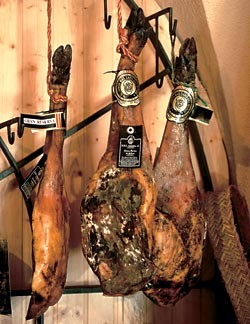 The birth of delicacy The first recipe for pickling pigslegs appeared in the book "De re agricola", written by Cato the Elder in the II century BC. e. (this is the same Mark Porcius Cato, who tirelessly called for the destruction of Carthage). In principle, the method of production has not changed much since that time. Yes, actually, there was no need for that either. The salting occurs as follows. First, the skin and excess fat are cut off from the pork legs, after which they are placed in a cold room, where they are covered with a large amount of salt. In this form, the hams remain for a few days until they are properly salted. Then the meat is washed off with excess salt and ham to dry. Moreover, this stage is multisyllabic - the hamons periodically move, from the drying out, from the rooms with a lower temperature to the halls with a higher one. Thus, the hamon "sweats" - from it comes excess moisture and fat. During the entire manufacturing process, it loses about 35% of the original moisture. And only then the hams are transported to special rooms, called old-fashioned "bodegas", that is, cellars, where final ripening takes place - usually 10-12 months. But do not think that this work - do not hit lying. During the entire drying and maturing period, the ham is constantly checked for any unwanted growths - fungi, molds, and then all these troubles are cut off with a sharpened knife. With those volumes, which are now produced by the jamon, there are enough cases. By the way, if you paid attention, the technological process described above reproduces quite accurately the cycle of changing seasons, beginning with winter. Earlier peasants hammered pigs in the autumn, salted ham, and further for business nature undertook. In this order over time, there has been one, but decisive change. The pigs began to be slaughtered, pre-fattened with acorns, which, as was said, are one of the decisive taste-forming factors in this matter. And by the way, the only factor that can not be reproduced artificially. While the temperature regime at the current level of development of refrigeration equipment is not so difficult to maintain artificially. Ending the process of drying meat is confirmed by experts. They are a thin long needle, made traditionally from the bone of a cow or a horse, make punctures and inhale the fragrance. As far as an objective criterion can be considered the ability of sniffs to determine the readiness of a product, it is difficult to answer, however, even if they make a little mistake, it's not scary. Hamon can still for two years to hang under the ceiling of a shop or restaurant. Under each of the hams will be strengthened a tiny funnel for the continued flow of fat. And it will come to the condition. True, it's rare which ham will last so long, there is always a demand. Accounting and control The control over the quality of wines is best known in the world. However, if the product deserves it, such control is established in cheese making, and, in this case, in the production of ham. So, the hamon is done all over Spain, except for the coast. The "sign of quality" of the hamons is called Denominacion de Origen. It is applied to every certified ham in the form of a special brand and ensures that this piece of jamon is produced in a certain province and in compliance with the same local standards. Each province has its own standards, and this circumstance gives the tastings a taste of adventure, in a good sense, of course. The Ministry of Agriculture of Spain identifies the following DdeO: Cecina de Leon ("Cecina de Leon"), Dehesa de Extremadura ("Dehesa de Extremadura"), Guijuelo ("Guihuelo"), Jamon de Huelva ("Hamon de Huelva"), Jamon de Teruel ("Jamon de Teruel"), Jamon de Trevelez ("Hamon de Treveles"). By the way, the jamon "Cecina de Leon" is produced not from pork, but from calf's legs - such an unexpected turn of intrigue. These brands - this is truly the highest league of the meat industry in Spain. And maybe the whole world.
The birth of delicacy The first recipe for pickling pigslegs appeared in the book "De re agricola", written by Cato the Elder in the II century BC. e. (this is the same Mark Porcius Cato, who tirelessly called for the destruction of Carthage). In principle, the method of production has not changed much since that time. Yes, actually, there was no need for that either. The salting occurs as follows. First, the skin and excess fat are cut off from the pork legs, after which they are placed in a cold room, where they are covered with a large amount of salt. In this form, the hams remain for a few days until they are properly salted. Then the meat is washed off with excess salt and ham to dry. Moreover, this stage is multisyllabic - the hamons periodically move, from the drying out, from the rooms with a lower temperature to the halls with a higher one. Thus, the hamon "sweats" - from it comes excess moisture and fat. During the entire manufacturing process, it loses about 35% of the original moisture. And only then the hams are transported to special rooms, called old-fashioned "bodegas", that is, cellars, where final ripening takes place - usually 10-12 months. But do not think that this work - do not hit lying. During the entire drying and maturing period, the ham is constantly checked for any unwanted growths - fungi, molds, and then all these troubles are cut off with a sharpened knife. With those volumes, which are now produced by the jamon, there are enough cases. By the way, if you paid attention, the technological process described above reproduces quite accurately the cycle of changing seasons, beginning with winter. Earlier peasants hammered pigs in the autumn, salted ham, and further for business nature undertook. In this order over time, there has been one, but decisive change. The pigs began to be slaughtered, pre-fattened with acorns, which, as was said, are one of the decisive taste-forming factors in this matter. And by the way, the only factor that can not be reproduced artificially. While the temperature regime at the current level of development of refrigeration equipment is not so difficult to maintain artificially. Ending the process of drying meat is confirmed by experts. They are a thin long needle, made traditionally from the bone of a cow or a horse, make punctures and inhale the fragrance. As far as an objective criterion can be considered the ability of sniffs to determine the readiness of a product, it is difficult to answer, however, even if they make a little mistake, it's not scary. Hamon can still for two years to hang under the ceiling of a shop or restaurant. Under each of the hams will be strengthened a tiny funnel for the continued flow of fat. And it will come to the condition. True, it's rare which ham will last so long, there is always a demand. Accounting and control The control over the quality of wines is best known in the world. However, if the product deserves it, such control is established in cheese making, and, in this case, in the production of ham. So, the hamon is done all over Spain, except for the coast. The "sign of quality" of the hamons is called Denominacion de Origen. It is applied to every certified ham in the form of a special brand and ensures that this piece of jamon is produced in a certain province and in compliance with the same local standards. Each province has its own standards, and this circumstance gives the tastings a taste of adventure, in a good sense, of course. The Ministry of Agriculture of Spain identifies the following DdeO: Cecina de Leon ("Cecina de Leon"), Dehesa de Extremadura ("Dehesa de Extremadura"), Guijuelo ("Guihuelo"), Jamon de Huelva ("Hamon de Huelva"), Jamon de Teruel ("Jamon de Teruel"), Jamon de Trevelez ("Hamon de Treveles"). By the way, the jamon "Cecina de Leon" is produced not from pork, but from calf's legs - such an unexpected turn of intrigue. These brands - this is truly the highest league of the meat industry in Spain. And maybe the whole world. A delicious ending, how is it?There are actually two questions here. The first is how to cut a jamon, if it is so huge, 5-7 kg, and at the same time on the bone? For this, there are special devices called "hamoners". They represent a special wooden stand with a clamp attached to a vertical bar. A ham leg is inserted into it, hoof up. By the way, the hoof is always left untouched until the very last piece of meat, because its black color is the most reliable confirmation that the ham is made from an Iberian pig, for the rest it is light. When the preparation process is over, start cutting the jamon. First, remove the outer thick layer of fat and then with a thin, flexible knife from the whole ham, cut the thinnest petals of the ham, rotating it around its own axis. Easier to tell than to do. To learn this art and get the profession of a cortador, you need not only to complete special courses, but also to have a talent for this business. In Spain, in the field of cutting ham work masters of such a level that they are even invited to tour. This is a real show, you know. No kidding. Technological progress, of course, has changed a lot. A fairly significant portion of the ham is now delivered boneless. Such a ham can be cut on an elementary slicer, which can be found in any buffet. Moreover, despite the indignation of the supporters of authenticity, jamon is sold pre-cut, and even in a vacuum package. The main thing is not to forget to take it out of the refrigerator 30 minutes before serving. Traditionally, this product is not stored in the refrigerator, it does not deteriorate anyway. The second question is with what to submit it? First of all, it is good in itself. And there is probably no product that is more self-sufficient. Further - like any dry-cured ham, jamon goes well with melon, tomato, fresh figs, pears and grapes. The sweeter the tomato, the better it goes with the ham. In general, in Spain, they experiment with jamon as they want: they cook with it a Spanish omelet "tortilla" (not to be confused with a Mexican unleavened flatbread), add it to fried mushrooms, and wrap tuna steaks in it. They even boil broth from a lonely remaining bone, and then soup on it. , Certainly. But only from "garbanzo" peas (we sell it under the name "Turkish peas"). And finally, a piece of advice that has been tested from personal experience: do not heat the jamon, add it to the dish shortly before it is fully cooked. To open up, he needs only 3-4 minutes. And finally, it is good to serve dry sherry with this ham. This combination is recognized as classic and unsurpassed. Although a glass of vodka "with a tear" will be quite appropriate.
A delicious ending, how is it?There are actually two questions here. The first is how to cut a jamon, if it is so huge, 5-7 kg, and at the same time on the bone? For this, there are special devices called "hamoners". They represent a special wooden stand with a clamp attached to a vertical bar. A ham leg is inserted into it, hoof up. By the way, the hoof is always left untouched until the very last piece of meat, because its black color is the most reliable confirmation that the ham is made from an Iberian pig, for the rest it is light. When the preparation process is over, start cutting the jamon. First, remove the outer thick layer of fat and then with a thin, flexible knife from the whole ham, cut the thinnest petals of the ham, rotating it around its own axis. Easier to tell than to do. To learn this art and get the profession of a cortador, you need not only to complete special courses, but also to have a talent for this business. In Spain, in the field of cutting ham work masters of such a level that they are even invited to tour. This is a real show, you know. No kidding. Technological progress, of course, has changed a lot. A fairly significant portion of the ham is now delivered boneless. Such a ham can be cut on an elementary slicer, which can be found in any buffet. Moreover, despite the indignation of the supporters of authenticity, jamon is sold pre-cut, and even in a vacuum package. The main thing is not to forget to take it out of the refrigerator 30 minutes before serving. Traditionally, this product is not stored in the refrigerator, it does not deteriorate anyway. The second question is with what to submit it? First of all, it is good in itself. And there is probably no product that is more self-sufficient. Further - like any dry-cured ham, jamon goes well with melon, tomato, fresh figs, pears and grapes. The sweeter the tomato, the better it goes with the ham. In general, in Spain, they experiment with jamon as they want: they cook with it a Spanish omelet "tortilla" (not to be confused with a Mexican unleavened flatbread), add it to fried mushrooms, and wrap tuna steaks in it. They even boil broth from a lonely remaining bone, and then soup on it. , Certainly. But only from "garbanzo" peas (we sell it under the name "Turkish peas"). And finally, a piece of advice that has been tested from personal experience: do not heat the jamon, add it to the dish shortly before it is fully cooked. To open up, he needs only 3-4 minutes. And finally, it is good to serve dry sherry with this ham. This combination is recognized as classic and unsurpassed. Although a glass of vodka "with a tear" will be quite appropriate.

Making Money with Desserts: Success Stories
Yevhen Polishchuk (Fedutinov) instagram: @ evgeniyafedutinovavk.com / janeshomebaking– It all started with baking for relatives and friends. Gradually, she began uploading photos of her baking to Instagram, and orders began to come in. I made my first cake to order on October 13, 2014, and a little earlier I started making macarons and cupcakes. We can say that the business "found me myself", I am very [...]

Soups are cold recipes with photos
Cold cucumber soup with yogurt and lemonSorbet from La Taverna restaurant chef Alexander Zhurkina Photo: Getty Images Ingredients: Yoghurt without additives - 125 gCucumber - 150 gSorbet lemon / lime - 50 gCool shrimp - 24 gFresh ginger - 1 gLime lime - 5 gFresh orange juice - 5 gPetroshka - 1 g pink - 1 gCress salad - […]

barbeque kebab
Pork tenderloin glaze Photos: Dmitry Bayrak / dbstudio Cooking time: 20 minutes + time for pickling. Calorie content: 454 kcal per 1 serving. For 4 servings: 4 pork tenderloin (about 300 g each), 1 onion, 2 cloves of garlic, 1 tsp. lemon peel, 1 tsp. lemon juice, a pinch of ground cumin, coriander and turmeric, 1 tbsp. l vegetable [...]

Pierre Duacan: dietary recipes: Ducane diet
Beetroot Photo: Season'S, Luxury Hotels Representation You will need: · Boiled beets - 60 g · Fresh cucumbers - 20 g · Red radish - 20 g · Green onions - 10 g · Egg - 1 pcs · Mineral drinking water - 200 g · Salt - 1 g Ready: · Boil egg and beetroot. · Grind cucumbers, radishes and a part of beets. Putting everything [...]





